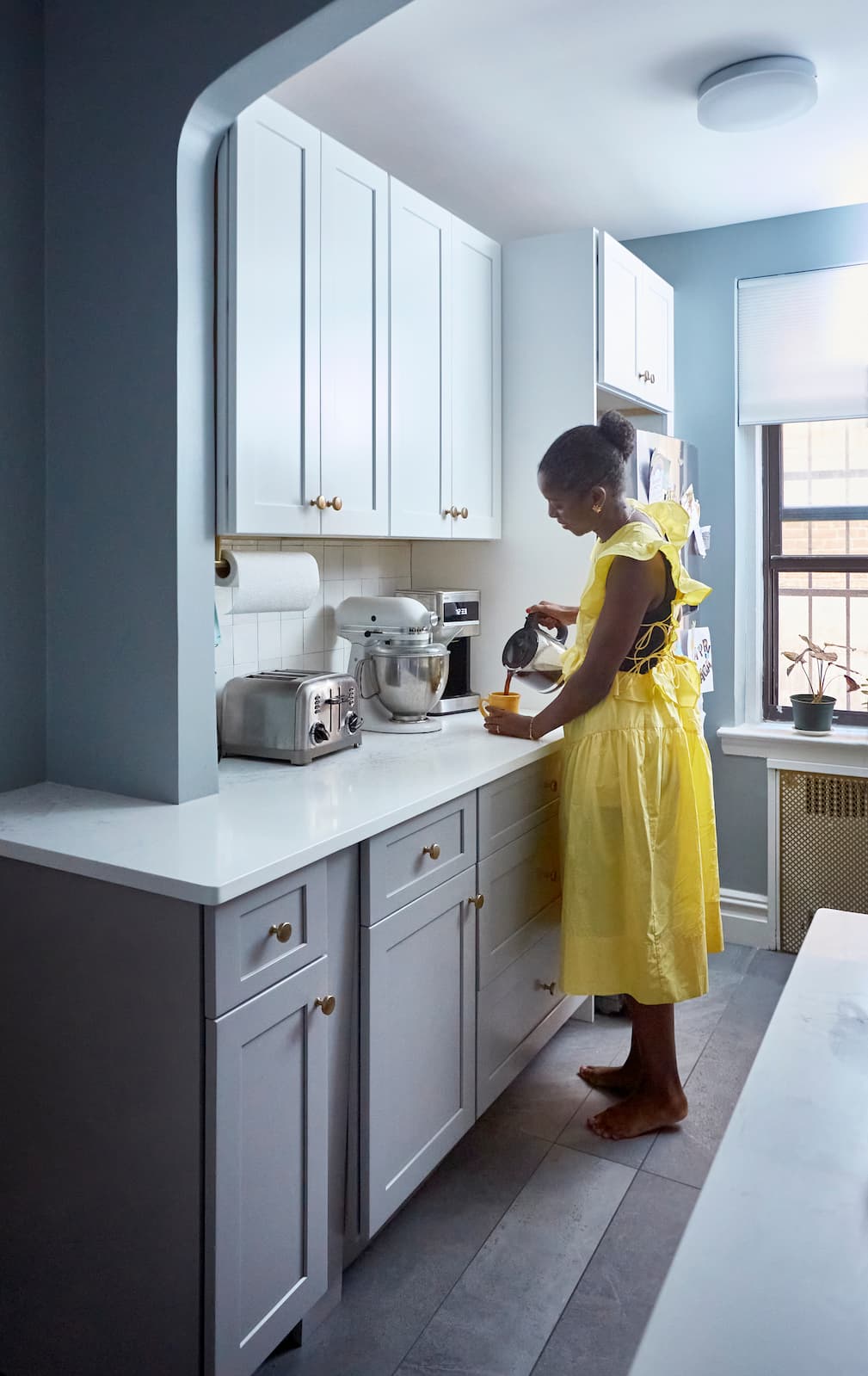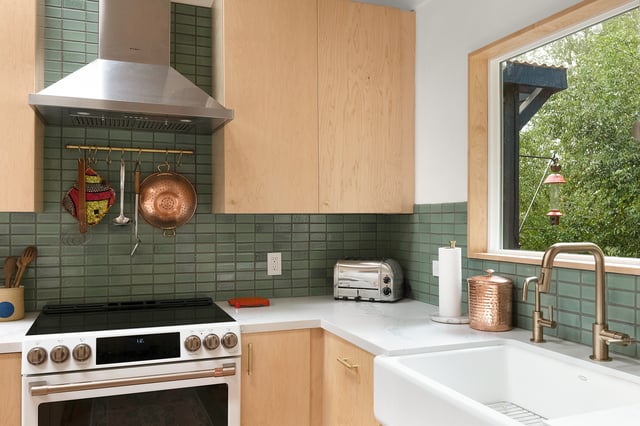
Finance
With Lower Interest Rates, Is Now a Good Time to Renovate?
09.18.2025


In This Article
Renovating your home takes more than a good idea and a few inspirational photos. It takes money—usually more than you’d expect—and some real decisions about how to spend it. Whether you’re finally fixing that cramped kitchen, updating a bathroom, or reworking your layout, figuring out how to pay for it is part of the job.
Design a Home That’s Uniquely Yours
Block can help you achieve your renovation goals and bring your dream remodel to life with price assurance and expert support.
Get Started
Some people save for years and pay in cash. Others use financing to get started sooner or avoid pulling from savings. A lot of homeowners do a mix of both. There’s no one-size-fits-all answer—and honestly, there shouldn’t be. Your payment strategy should make sense for your project and your financial life, not just what sounds smart on paper.
That’s what this guide is here for. We’ll walk through what renovations actually cost, how different payment options work, and how to make choices that won’t keep you up at night. The goal? Help you move forward with a plan you feel good about—on the build site and in your budget.
Let’s get this part out of the way: renovations are expensive. Even small ones. A basic kitchen upgrade might start around $25,000. A bigger one—new layout, custom cabinets, upgraded appliances—can double or triple that. Bathroom remodels can run from $15,000 to $40,000. And if you’re remodeling the whole house? Think six figures, easily.
But it’s not just the obvious stuff like tile and countertops. It’s permits. It’s labor. It’s materials that suddenly cost more than they did three months ago. And then there’s the stuff you don’t see coming—like water damage behind a wall or wiring that needs to be brought up to code. Those “surprises” are so common that they’re basically expected.
That’s why most contractors and planners will tell you to build in a buffer of 10% to 20% of your total budget. Not because you’ll spend it recklessly but because if something needs fixing, you’ll want room to handle it without derailing the project.
Getting a real grip on your budget upfront makes every other decision easier, including how you’re going to pay for it.
Paying with savings gives you complete control over your renovation budget from day one. It also allows you to move forward without waiting for loan approvals or taking on new financial commitments.
Using your own savings is the most straightforward way to pay for a renovation. It eliminates the need to apply for loans, manage monthly payments, or deal with interest. There’s a certain freedom in knowing the project is paid in full upfront.
It also simplifies budgeting. Without a lender involved, you have full control over how and when money is spent. And because you’re not taking on debt, there’s less financial pressure once the work is done—especially useful if you're trying to maintain a tight monthly budget.
This approach also provides peace of mind. You’re not beholden to a bank, your credit score isn’t a factor, and you avoid the paperwork and fees that come with financig. For smaller renovations or homeowners who’ve set aside funds for this purpose, paying out of pocket can feel empowering.
There’s also the satisfaction of owning your upgrades outright. No lingering balance. No ongoing monthly reminder.
Paying with savings sounds simple—and it is, to a point—but there are a few ways it can put pressure on you. If the renovation eats up most of what you’ve got set aside, especially your emergency fund, you’re exposed if something else goes wrong. That could be anything from a medical issue to car trouble to a surprise job shift. When there’s no cushion left, even a small setback can feel bigger than it should.
There’s also what you lose by using the money. If those funds were in a high-yield account, invested, or earmarked for something else—retirement, college, another goal—you’re giving up potential growth. That’s called opportunity cost, and while it doesn’t show up as a line item in your budget, it’s real.
And then there’s the question of flexibility. If your savings can only stretch so far, you might find yourself cutting corners to stay on budget. That could mean skipping features you really wanted, settling for lower-quality materials, or having to compromise mid-project. Sometimes that’s fine. Other times, it means ending up with a space that doesn’t quite do what you hoped it would.
Renovate now, pay later
Achieve the space you're looking for today, while financing it over time with our trusted partner.*
*Not available in NYC
Learn More
Not everyone wants—or can—to pay for a renovation in cash, especially if the scope is big or the timing can’t wait. Financing can make things possible that otherwise wouldn’t be. It can also help you hold onto your savings for other priorities: retirement, an emergency fund, travel, even just breathing room.
There are a few different ways to go about it. The best option depends on your credit, income, and how structured or flexible you want your payments to be.
For many homeowners, financing enables tackling a larger or more urgent renovation without wiping out savings. Several options exist depending on your needs and financial profile.
Financing doesn’t always mean you’re in a tough spot—it can just mean you’re being strategic. Let’s say you’ve got a renovation you’re ready to move on, but you’re not crazy about the idea of pulling $40,000 from your savings all at once. That’s a pretty common place to be. A loan can give you the room to move ahead without emptying your bank account.
It also gives you flexibility with how the money is used. If you're spreading payments out over a few years, you might feel more comfortable investing in better materials that last longer or function better. Maybe you were planning on basic cabinets, but financing lets you go for something more durable that won’t need replacing in five years. That kind of upgrade isn’t just about looks—it can help with resale or reduce long-term maintenance headaches.
And then there’s just the peace of mind. Having a reserve in the bank while still being able to move forward with your project can be a huge relief. You’re not wondering if an unexpected expense will leave you short on cash halfway through the job.
Some financing options even come with fixed payments, which can help you plan your monthly budget. You know what’s going out, when, and for how long. It’s not fun debt, but it’s manageable—and that counts for something.
Also, if you’re using a home equity loan and the project adds value to your house, you’re potentially turning borrowed money into long-term equity. That doesn’t happen with every expense. You’re not just spending—you’re investing in your space.
That said, borrowing money for a renovation isn’t always the easy answer. It comes with strings. Interest, for one. Even if the rate’s decent, you’re still paying extra money on top of the project itself. Over the life of the loan, it can add up more than people expect.
And depending on the lender and the loan type, you might need to meet a certain credit score or income threshold. If your finances aren’t super steady right now, or your credit’s been dinged for any reason, it might be harder to qualify—or the terms might not be as favorable as you’d hoped.
There’s also the mental load of it. Once you’ve signed for the loan, whether you feel ready or not, those payments are there. That can get stressful, especially if something in your life shifts—like you change jobs or run into other big expenses. Renovation loans aren’t something you can pause midstream.
And here's the part people don’t always talk about: it’s really easy to borrow more than you need. Renovations tend to snowball. You start with a plan, then midway through, you think “while we’re at it, let’s also…” and suddenly you’ve added thousands to the bill. If you're working with borrowed money, that temptation can grow fast.
So it’s not just about “can I get financing?” but “should I borrow this much?” and “will I still feel good about this six months from now?”
If you’re clear on your budget, confident in your repayment plan, and honest about what you really want to take on—financing can work well. But it’s not something to enter into casually.
When deciding how to fund your renovation, a few key factors can help guide the choice between using savings, financing, or a mix of both:
Using savings often makes the most sense when the project is on the smaller side and your finances are in a good place. Things like updating light fixtures, repainting, or swapping out flooring are usually manageable without borrowing—and they’re easier to scale to your budget.
It’s also a smart move if you’re close to retirement or just don’t like the idea of taking on debt. There’s something reassuring about finishing a renovation and knowing it’s fully paid for. No monthly bills, no interest—just a done project and one less thing to think about.
Renovate with confidence every step of the way
Step 1: Personalize Your Renovation Plan
Step 2: Receive Quotes from Trusted Contractors
Step 3: Let Us Handle the Project Details

Financing makes sense when the renovation is large, time-sensitive, or directly impacts home value. A full kitchen remodel or ADU (accessory dwelling unit) addition, for example, may be out of reach without it.
Borrowing is also smart when you want to keep reserves intact—for emergencies, investments, or other financial goals. And in some cases, the renovation itself might generate income or savings (like energy-efficient upgrades), offsetting some of the borrowing costs over time.
Splitting renovation costs between savings and financing can offer the best of both worlds—if it’s done with a clear plan. This approach lets you use savings where it makes sense, while financing the parts of your project that would otherwise strain your budget. For many homeowners, it’s a practical middle ground: less debt than full financing, less financial risk than draining your savings.
One of the biggest advantages is that it gives you flexibility. You can cover early-stage costs like planning, design, or initial deposits with savings, and save financing for construction milestones, materials, or unexpected changes. This helps you stay in control of cash flow without putting everything on a credit line from the start. It may also improve your loan terms—since borrowing less often leads to shorter repayment periods and lower total interest.
Still, there are tradeoffs. A hybrid strategy can be harder to manage if you’re not tracking your budget closely. Without discipline, it’s easy to dip further into savings than planned or underestimate how much you’ll owe later.
Pros of combining savings and financing:
Cons:
To manage risk and maximize flexibility, start by defining what portion of your savings you’re willing to spend—and keep your emergency fund off-limits. Then, look at loan options that align with the scale of your remaining costs. Use savings for the more predictable parts of your project, and financing where costs might fluctuate. Leave breathing room in both your budget and your repayment schedule, so surprises don’t throw everything off.
When done thoughtfully, a hybrid approach can help you get the renovation you really want—without sacrificing long-term financial stability.
Turn your renovation vision into reality
Get matched with trusted contractors and start your renovation today!
Find a Contractor
There’s no one-size-fits-all answer when it comes to paying for a renovation. Some homeowners want the clean simplicity of using savings. Others need the reach and flexibility that financing provides. Many land somewhere in between.
The right choice comes down to your personal goals, financial habits, and risk tolerance. Start with a solid renovation plan, create a realistic budget, and choose a payment method that supports your bigger picture—not just your immediate project.
And if you’re unsure, don’t guess. Talk to a Project Planner or financial advisor. A well-structured plan today can make all the difference in how you enjoy your renovated space tomorrow.
Block Renovation is here to help with expert planning tools, vetted contractors, and support at every step. No matter how you pay, we’re here to make sure you get the most out of your renovation.

Written by Block Renovation

Renovate confidently with Block
Easily compare quotes from top quality contractors, and get peace of mind with warranty & price protections.
Thousands of homeowners have renovated with Block

4.5 Stars (100+)

4.7 Stars (100+)

4.5 Stars (75+)

Finance
With Lower Interest Rates, Is Now a Good Time to Renovate?
09.18.2025

Finance
Smart Ways to Finance a Home Addition
09.18.2025

Finance
What’s the Best Way to Pay for Home Renovations: Savings or Financing?
05.23.2025

Finance
The Top Renovations That Increase Home Value in 2025
05.22.2025

Cost
How Much Does it Cost to Renovate a Studio Apartment?
05.16.2025
Renovate confidently